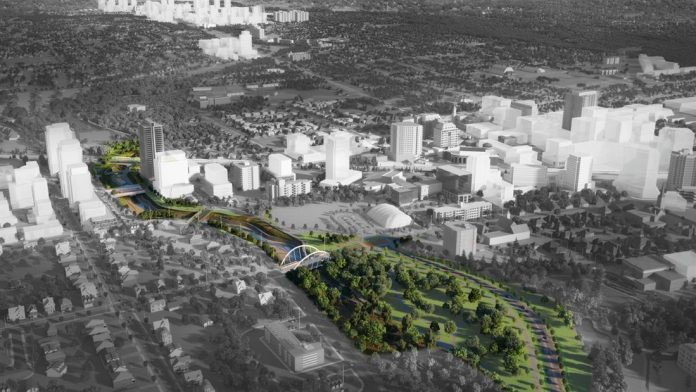GTA Construction News staff writer
The City of Brampton has kicked off construction on the Downtown Brampton Flood Protection Project, marking the start of the first phase of its multi-year Riverwalk initiative.
Work is expected to protect the downtown core from future flooding and remove long-standing redevelopment barriers in the city’s historic centre.
AECOM is leading the detailed design work for the project. The city is also in the process of procuring a construction manager: Brampton issued RFP 2025-105 on July 11 and closed the competition on Oct. 2, though a contract award has not yet been announced.
Early site preparation is expected to begin in the coming weeks. Full construction is scheduled to start in early 2026 and continue through spring 2028, completing the first phase of Riverwalk.
The flood-protection system will modernize and expand infrastructure along Etobicoke Creek. Once complete, the new system is expected to exceed Ontario’s regulatory flood standards and withstand storm events comparable to or greater than Hurricane Hazel, including rainfall of up to roughly 285 millimetres over 48 hours.
Downtown Brampton lies within the Etobicoke Creek floodplain, an area historically vulnerable to severe flooding. The most damaging event occurred in March 1948, when more than 1.8 metres of water inundated the Main and Queen Streets intersection, causing nearly $500,000 in damage and prompting construction of the diversion channel completed in 1952.
Phase One of Riverwalk will deepen and widen the creek channel to reduce flood risk and unlock new development potential. The city says the improvements will support growth that could accommodate roughly 17,700 residents and create about 23,800 jobs, including 2,200 construction positions. The project is also expected to open up 3.6 million square feet of residential, commercial and retail space.
Phase Two, beginning after 2030, will implement an Urban Design Master Plan introducing new parks, public spaces, trails, homes and business areas along the reconfigured corridor.
The project is supported by all three levels of government and the Toronto and Region Conservation Authority. Ottawa is contributing more than $38.8 million through the Disaster Mitigation and Adaptation Fund, while Ontario is providing nearly $50 million through its Municipal Housing Infrastructure Program.








